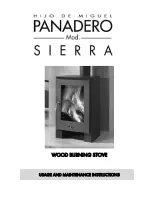
32
Destination 1.6 Installation and Operation Manual
6.2 Regulations Covering Stove Installation
When installed and operated as described in these instructions, the Destination 1.6 wood stove is
suitable for use as a freestanding heater in residential installations. The Destination 1.6 wood stove
is not recommended for installation in a sleeping room of a mobile home.
In Canada, the CSA B365 Installation Code for Solid Fuel Burning Appliances and Equipment and
the CSA C22.1 Canadian National Electrical Code are to be followed in the absence of local code
requirements. In the USA, the ANSI NFPA 211 Standard for Chimneys, Fireplaces, Vents and
Solid Fuel-Burning Appliances and the ANSI NFPA 70 National Electrical Code are to be followed
in the absence of local code requirements.
This stove must be connected to a chimney complying with the requirements for Type HT
chimneys in the Standard for Factory-Built Chimneys for Residential Type and Building Heating
Appliances, UL 103 and ULC S629 or to a code-approved masonry chimney with a flue liner.
















































